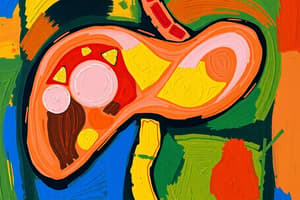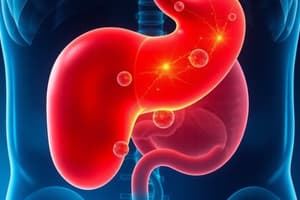Podcast
Questions and Answers
What is the indicated treatment for asymptomatic patients with gallstones and low risk for complications?
What is the indicated treatment for asymptomatic patients with gallstones and low risk for complications?
- Administration of antibiotics
- Immediate diagnostic testing
- Surgical removal of the gallbladder
- Conservative treatment (correct)
Elevated direct bilirubin levels indicate normal bile flow.
Elevated direct bilirubin levels indicate normal bile flow.
False (B)
What diagnostic test can accurately diagnose cholelithiasis?
What diagnostic test can accurately diagnose cholelithiasis?
Ultrasonography
The water-soluble form of bilirubin is called __________.
The water-soluble form of bilirubin is called __________.
Which test uses a dye administered orally to evaluate gallbladder function?
Which test uses a dye administered orally to evaluate gallbladder function?
Match the following diagnostic tests with their features:
Match the following diagnostic tests with their features:
A high WBC count in a CBC test suggests the presence of infection and inflammation.
A high WBC count in a CBC test suggests the presence of infection and inflammation.
What may elevated serum amylase and lipase levels indicate?
What may elevated serum amylase and lipase levels indicate?
What is the primary purpose of inserting a T-tube during a cholecystectomy with common bile duct exploration?
What is the primary purpose of inserting a T-tube during a cholecystectomy with common bile duct exploration?
Laparoscopic cholecystectomy generally requires a hospital stay of more than 24 hours.
Laparoscopic cholecystectomy generally requires a hospital stay of more than 24 hours.
What procedure may be performed if a stone is suspected to have been retained after surgery?
What procedure may be performed if a stone is suspected to have been retained after surgery?
The procedure used to break down large gallstones using shock waves is called __________.
The procedure used to break down large gallstones using shock waves is called __________.
Match the procedure with its description:
Match the procedure with its description:
Which of the following is a common nursing care task after laparoscopic cholecystectomy?
Which of the following is a common nursing care task after laparoscopic cholecystectomy?
Mild sedation is usually avoided during the extracorporeal shock wave lithotripsy procedure.
Mild sedation is usually avoided during the extracorporeal shock wave lithotripsy procedure.
What is the risk associated with laparoscopic cholecystectomy?
What is the risk associated with laparoscopic cholecystectomy?
What is the primary disadvantage of pharmacologic therapy for gallstones?
What is the primary disadvantage of pharmacologic therapy for gallstones?
Antibiotics are not used in the treatment of infections associated with gallstones.
Antibiotics are not used in the treatment of infections associated with gallstones.
What is the purpose of cholestyramine in gallstone treatment?
What is the purpose of cholestyramine in gallstone treatment?
Cholecystitis can be managed nonpharmacologically by inserting a __________ to relieve nausea and vomiting.
Cholecystitis can be managed nonpharmacologically by inserting a __________ to relieve nausea and vomiting.
Match the gallstone dissolution drugs with their examples:
Match the gallstone dissolution drugs with their examples:
Which type of gallstones are most effectively treated with pharmacologic therapy?
Which type of gallstones are most effectively treated with pharmacologic therapy?
Pharmacologic treatment of gallstones can lead to a reduction in stone formation when treatment is stopped.
Pharmacologic treatment of gallstones can lead to a reduction in stone formation when treatment is stopped.
What might happen to bilirubin levels when bile flow from the gallbladder is obstructed by a gallstone?
What might happen to bilirubin levels when bile flow from the gallbladder is obstructed by a gallstone?
What is the primary reason for converting from laparoscopic cholecystectomy to laparotomy during a procedure?
What is the primary reason for converting from laparoscopic cholecystectomy to laparotomy during a procedure?
All patients can undergo laparoscopic cholecystectomy safely.
All patients can undergo laparoscopic cholecystectomy safely.
What is inserted to maintain patency of the duct during common bile duct exploration?
What is inserted to maintain patency of the duct during common bile duct exploration?
Extracorporeal shock wave lithotripsy uses __________ to align gallstones with shock waves.
Extracorporeal shock wave lithotripsy uses __________ to align gallstones with shock waves.
Match the procedure with its indication:
Match the procedure with its indication:
In patients with mild sedation during extracorporeal shock wave lithotripsy, what is the main purpose of this sedation?
In patients with mild sedation during extracorporeal shock wave lithotripsy, what is the main purpose of this sedation?
A postoperative cholangiogram is performed only if bile flow is normal.
A postoperative cholangiogram is performed only if bile flow is normal.
What type of medication may be used to treat chronic pain during gallbladder attacks?
What type of medication may be used to treat chronic pain during gallbladder attacks?
Flashcards are hidden until you start studying
Study Notes
Cholelithiasis and Cholecystitis Treatment
- Conservative treatment is recommended for asymptomatic gallstones with a low risk for complications.
- Surgical removal of the gallbladder and stones is usually indicated for patients experiencing frequent symptoms, acute cholecystitis, or very large stones.
Diagnostic Tests
- Elevated direct bilirubin levels can indicate obstructed bile flow in the biliary duct system.
- Elevated white blood cell count may indicate infection and inflammation.
- Serum amylase and lipase levels are measured to identify possible pancreatitis related to common duct obstruction.
- Abdominal x-ray may show gallstones with high calcium content.
- Ultrasonography of the gallbladder is a noninvasive test that accurately diagnoses cholelithiasis and assesses gallbladder emptying.
- Oral cholecystogram evaluates the gallbladder's ability to concentrate and excrete bile using an oral dye.
- Gallbladder scan (cholescintigraphy or HIDA scan) employs an IV radioactive solution to assess cystic duct obstruction and acute/chronic cholecystitis.
Bilirubin Levels
- Total bilirubin includes both indirect (unconjugated) and direct (conjugated) bilirubin.
- Indirect bilirubin is bound to albumin and transported to the liver.
- Direct bilirubin is water-soluble and excreted in bile.
- Normal total bilirubin levels for adults are 0.1 to 1.2 mg/dL.
- Elevated total bilirubin levels can occur due to increased production or impaired metabolism/excretion.
- Normal direct bilirubin levels for adults are 0.1 to 0.3 mg/dL.
- Elevated direct bilirubin levels can occur due to impaired excretion from liver or biliary system obstruction.
- Normal indirect bilirubin levels for adults are less than 1.1 mg/dL.
- Elevated indirect bilirubin levels can occur due to red blood cell hemolysis.
Laparoscopic Cholecystectomy
- Laparoscopic cholecystectomy is the preferred treatment for symptomatic gallstones or gallbladder inflammation.
- This minimally invasive procedure typically results in a short hospital stay of less than 24 hours.
- While generally safe, a laparoscopic cholecystectomy may need to be converted to an open abdominal surgery (laparotomy) during the procedure.
Common Bile Duct Exploration
- When gallstones are lodged in the bile ducts, a cholecystectomy with common bile duct exploration may be performed.
- A T-tube is inserted into the common bile duct to maintain patency and facilitate bile flow.
- Excess bile is collected in a drainage bag secured below the surgical site.
Postoperative Cholangiogram
- If a retained stone is suspected after surgery, a cholangiogram (imaging of the bile ducts) via the T-tube or endoscopic visualization of the duct may be performed.
Alternative Procedures
- Cholecystostomy (draining the gallbladder) or choledochostomy (removing stones and placing a T-tube) may be considered for high-risk patients who are not suitable for laparoscopic cholecystectomy.
- Shock wave lithotripsy, using ultrasound to break down large gallstones, can be used in conjunction with drug therapy.
Extracorporeal Shock Wave Lithotripsy
- This procedure requires precise positioning and typically takes an hour to complete.
- Mild sedation may be administered during the procedure.
Nursing Care After Gallstone Procedures
- Postoperative care includes monitoring for biliary colic (pain from gallbladder contractions to remove fragments), nausea, and transient hematuria (blood in the urine).
Percutaneous Cholecystostomy
- This procedure, using ultrasound guidance to drain the gallbladder, can be performed on high-risk patients to postpone or potentially avoid surgery.
Laparoscopic Cholecystectomy
- The gold standard treatment for symptomatic gallstones or inflammation of the gallbladder
- Minimally invasive, with low complication risk
- Usually requires less than 24 hours of hospital stay
- Some patients may not be candidates for this procedure
- May be converted to laparotomy if necessary during surgery
Cholecystectomy with Common Bile Duct Exploration
- Performed when stones are lodged in the ducts
- T-tube inserted to maintain duct patency and promote bile passage
- Excess bile is collected in a drainage bag
- Post-operative cholangiogram or endoscopy may be performed to check for retained stones
Alternative Treatments
- Cholecystostomy: Drains the gallbladder in high-risk patients
- Choledochostomy: Removes stones and positions a T-tube in the common bile duct (for high-risk patients)
- Shock Wave Lithotripsy: Uses ultrasound to break up large gallstones
- Percutaneous Cholecystostomy: Ultrasound-guided drainage of the gallbladder in high-risk patients
Pharmacologic Therapy
- NSAIDS: Treat chronic pain of gallbladder attacks
- Narcotic Analgesics (e.g., morphine): Used for pain relief during acute attacks
- Dissolving Drugs (e.g., chenodiol, ursodiol): For non-calcified stones less than 20mm in diameter
- Antibiotics: For suspected gallbladder infection
- Cholestyramine (Questran): Binds with bile salts to promote their excretion, treating pruritus
Nonpharmacologic Therapy
- Nasogastric tube: Inserted to relieve nausea and vomiting during acute cholecystitis
- Dietary fat limitation: Especially for obese patients
- Fat-soluble vitamin and bile salt supplementation: If bile flow is obstructed
Nursing Considerations
- Monitor for biliary colic: Following lithotripsy
- Monitor for nausea: Post-procedure
- Monitor for transient hematuria: Post-procedure
- Advise on dietary limitations and potential side effects of medications
- Educate on goldenseal contraindications (pregnancy, breastfeeding)
Studying That Suits You
Use AI to generate personalized quizzes and flashcards to suit your learning preferences.




